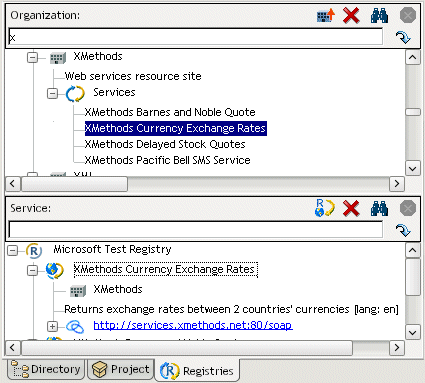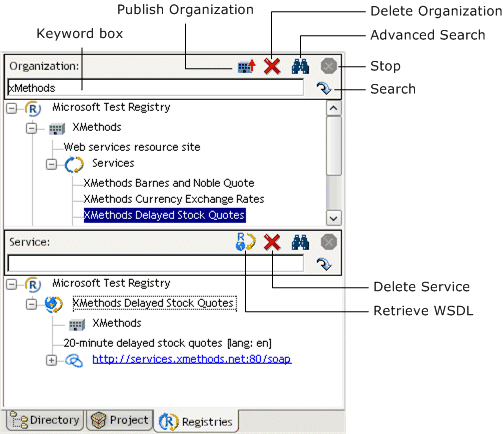
Utility Tools
CHAPTER 12
This chapter describes the registry browsing and publishing functionality provided by the Novell exteNd Director development environment. It contains the following topics:
The exteNd Director development environment supports the following registry standards:
The exteNd Director development environment provides a Registry Manager (accessible through the Registries tab in the Navigation Pane) and a facility for defining registry profiles. The registry capabilities include:
Viewing business information on selected organizations in a given registry
Viewing information on Web Services offered by a given organization
Searching for organizations or services within a registry or group of registries, optionally using extended query parameters
Registries are specified by URL and can be local or Web-based. Before accessing a registry in the exteNd Director development environment, you define a profile for that registry. Some predefined registry profiles are provided.
If you are editing or deleting an existing profile, select it from the Profile name list box and click Edit or Delete. If you are creating a new profile, click New.
When the New (or Edit) dialog displays, first specify the following:
|
Option |
Description |
|---|---|
|
Profile name |
Name of the profile |
|
Registry type |
Type of registry: ebXML, UDDI, or WSIL The dialog displays different options depending on which registry type you select. |
If you select ebXML or UDDI as the registry type, the dialog displays:
Complete the dialog as follows:
If you select WSIL as the registry type, the dialog displays:
Complete the dialog as follows (use the + and - buttons to add or delete entries in the WSIL registry list):
Once you have defined a registry profile, you can use the Registry Manager to browse the registry and you can publish services to the registry.
The Registry Manager allows you to browse registries through the Registries tab in the Navigation Pane. There are two subpanes within the Registries tab: the Organization Pane and the Service Pane.

The Registry Manager displays the following types of information.
Organization Pane The organization section of a registry might include these types of information:
Service Pane A service entry in a registry might include these types of information:
Each pane in the Registry Manager has a popup menu.
Organization Pane To view the popup menu for Organization, place the cursor in an entry in the Organization Pane and right-click. The following menu displays.
|
Menu item |
Description |
|---|---|
|
Copy Text |
Allows you to copy text from the currently selected organization tree node to another area or file |
|
Clear Tree |
Clears the pane of organization information that you retrieved from your search |
|
Delete Organization |
Deletes the selected organization (if you have permission). Asks you to confirm before deleting the organization. |
|
Advanced Search |
Allows you to perform a sophisticated search by organization
|
Service Pane To view the popup menu for Service, place the cursor in an entry in the Service pane and right-click. The following menu displays.
|
Menu item |
Description |
|---|---|
|
Copy Text |
Allows you to copy text from the currently selected service tree node to another area or file |
|
Clear Tree |
Clears the pane of service information that you retrieved from your search |
|
Retrieve WSDL |
Retrieves the WSDL for the selected service from the registry. You can also do this using the Retrieve WSDL button. |
|
Delete Service |
Deletes the selected service (if you have permission). Asks you to confirm before deleting the service. |
|
Advanced Search |
Allows you to perform a sophisticated search by service
|
The following illustration shows the location of the various action buttons on the Organization and Service panes.

You search by organization in the Organization Pane.
 To search organizations by name or keyword:
To search organizations by name or keyword:
Enter a complete or partial organization name or keyword in the text box below Organization.
TIP: You can also enter a group of organization names separated by a vertical bar, which allows you to search for multiple groups of organizations. For example: XMethods|IBM|Sun.
Click the Search button (shaped like a downturned arrow).
While the search is under way, the Stop button (normally grayed out) is red. The search can take several minutes. To interrupt the search, click the Stop button; partial search results will display in the Organization Pane.
A list of matching organizations appears in tree-view form. Each top-level node in the tree is a registry, each child of a registry is an organization name, and below each organization is detail information consisting of descriptions, categories, and services.
Clicking a service entry in the (upper) Organization tree causes that service's detail information to appear in tree form in the (lower) Service Pane.
 To set advanced organization search criteria:
To set advanced organization search criteria:
Click the Advanced Search button (shaped like binoculars).
Select one of the search-criteria options:
Organization Name—Enter a complete or partial organization name or list of names separated by a vertical bar (|) in the Starting with text box.
Identifier—Select one of the following: D-U-N-S or Thomas Register (catalog names) from the dropdown list. Enter a key from the catalog (partial or complete) in the Starting with text box; this entry can contain numeric values and dashes.
Locator—Select one of the following from the dropdown list: NAICS (North American Industry Classification System), UNSPSC (United Nations Standard Products and Services Classification), or GEO (geographical).
Enter a key from the catalog (partial or complete) in the Starting with text box if you selected NAICS or UNSPSC; this entry can contain numeric values. Enter a country (region) abbreviation for GEO. If you selected NAICS or UNSPSC, you can click the ellipsis and pick an item from a list of choices.
Service Type Name—Select to search organizations associated with a particular tModel.
Discovery URL—Enter an IP address or portion of an IP address for the URL in the Starting with text box.
Under Profiles, select the registry or registries to search from the list. Those you specified in the Profiles dialog for automatic searching are already selected. To override the search list, select one or all of the registries in the list. To return to the original (default) registries, click Reset.
You search by service in the Service Pane.
 To search services by name or keyword:
To search services by name or keyword:
Enter a complete or partial service name or keyword in the text box below Service.
TIP: You can also enter a group of service names separated by a vertical bar, which allows you to search for multiple groups of services.
Click the Search button (shaped like a downturned arrow).
While the search is under way, the Stop button (normally grayed out) is red. The search can take several minutes. To interrupt the search, click the Stop button; partial search results display in the Service Pane.
A list of matching services appears in tree-view form. Each top-level node in the tree is the registry that was searched; each immediate child of a registry is a service name; and children of the service node(s) contain detail information consisting of the organization name associated with the service, a description of the service, and bindings for the service.
Clicking a service node in the (lower) Service tree causes that organization's detail information to appear in tree form in the (upper) Organization Pane.
 To set advanced service search criteria:
To set advanced service search criteria:
Click the Advanced Search button (shaped like binoculars).
Select one of the search-criteria options:
Service Name—Enter a complete or partial service name in the Starting with text box.
Locator—Select one of the following: NAICS (North American Industry Classification System), UNSPSC (United Nations Standard Products and Services Classification), UDDITYPE, or GEO (geographical) from the dropdown list.
Enter a key from the catalog (partial or complete) in the Starting with text box if you selected NAICS, UNSPSC, or UDDITYPE; this entry can contain numeric values. Enter a country (region) abbreviation for GEO. If you selected NAICS, UNSPSC, or UDDITYPE, you can click the ellipsis and pick an item from a list of choices.
Service Type Name—Allows the search of services associated with a particular tModel.
Under Profiles, select the registry or registries to search from the list. Those you specified in the Profiles dialog for automatic searching are already selected. To override the search list, select one or all of the registries in the list. To return to the original (default) registries, click Reset.
While searching in the Registry Manager, you can use the percent sign (%) as a wildcard symbol, meaning one or more of any character. This is especially useful when you want to search for organization or service names that contain a particular word but might not start with that word.
The default search logic is Start With. So a search on Books will turn up BooksRUs but not ABC Booksellers or Used Books. The way to override this behavior is to search instead on %Books%, which will turn up all three.
You can also use the | (pipe) symbol as a logical OR to look for hits that contain any combination of specified words. You can chain together any number of keywords this way. For example:
%Booking% | %Travel% | %Airline%
returns all names that contain at least one of these words, no matter where in the name that word appears.
After you have found the service you searched for, you can retrieve the WSDL definition for this service from the registry. For this you use the Service Pane.
 To retrieve a WSDL definition from the registry:
To retrieve a WSDL definition from the registry:
Click the Retrieve WSDL button in the Service Pane.
If a definition for the service exists, the WSDL Editor displays the WSDL information.
 For information about the WSDL Editor, including different ways to view the WSDL, see WSDL Editor.
For information about the WSDL Editor, including different ways to view the WSDL, see WSDL Editor.
When you have created a WSDL document, you can publish it to a registry via the WSDL Editor.
 For information about the WSDL Editor, see WSDL Editor.
For information about the WSDL Editor, see WSDL Editor.
 To publish WSDL to a registry:
To publish WSDL to a registry:
Click the Publish to Registry button on the toolbar.
If your service is successfully published, you see a confirmation dialog. Otherwise, you see a dialog describing the error.
If you want to publish an organization to a registry, you can do that from the Organization Pane of the Registry Manager.
 To publish an organization to a registry:
To publish an organization to a registry:
Click the Publish Organization button in the Organization Pane.
If your organization is successfully published, you see a confirmation dialog. Otherwise, you see a dialog describing the error.
Copyright © 2004 Novell, Inc. All rights reserved. Copyright © 1997, 1998, 1999, 2000, 2001, 2002, 2003 SilverStream Software, LLC. All rights reserved. more ...